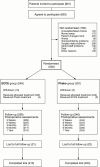Extracapsular cataract extraction compared with small incision surgery by phacoemulsification: a randomised trial
- PMID: 11423457
- PMCID: PMC1724033
- DOI: 10.1136/bjo.85.7.822
Extracapsular cataract extraction compared with small incision surgery by phacoemulsification: a randomised trial
Erratum in
- Br J Ophthalmol 2001 Dec;85(12):1498
Abstract
Background: Cataract extraction constitutes the largest surgical workload in ophthalmic units throughout the world. Extracapsular cataract extraction (ECCE), through a large incision, with insertion of an intraocular lens has been the most widely used method from 1982 until recently. Technological advances have led to the increasing use of phacoemulsification (Phako) to emulsify and remove the lens The technique requires a smaller incision, but requires substantial capital investment in theatre equipment. In this randomised trial we assessed the clinical outcomes and carried out an economic evaluation of the two procedures.
Methods: In this two centre randomised trial, 232 patients with age related cataract received ECCE, and 244 received small incision surgery by Phako. The main comparative outcomes were visual acuity, refraction, and complication rates. Resource use was monitored in the two trial centres and in an independent comparator centre. Costs calculated included average cost per procedure, at each stage of follow up.
Results: Phako was found to be clinically superior. Surgical complications and capsule opacity within 1 year after surgery were significantly less frequent, and a higher proportion achieved an unaided visual acuity of 6/9 or better (<0.2 logMAR) in the Phako group. Postoperative astigmatism was more stable in Phako. The average cost of a cataract operation and postoperative care within the trial was similar for the two procedures. With the input of additional spectacles for corrected vision at 6 months after surgery, the average cost per procedure was pound359.89 for Phako and pound367.57 for ECCE.
Conclusion: Phako is clinically superior to ECCE and is cost effective.
Figures


Comment in
-
Factoring cost, is phacoemulsification still the procedure of choice?Br J Ophthalmol. 2001 Jul;85(7):765-6. doi: 10.1136/bjo.85.7.765. Br J Ophthalmol. 2001. PMID: 11423441 Free PMC article. No abstract available.
References
Publication types
MeSH terms
LinkOut - more resources
Full Text Sources
